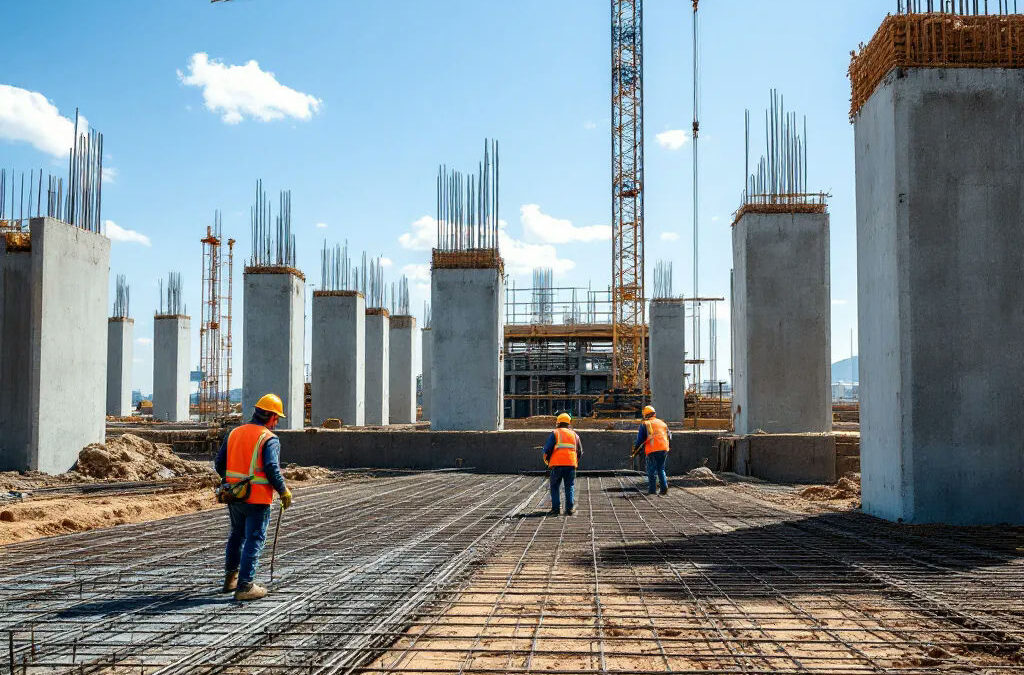I. Introduction
Concrete reinforcement is a vital process in construction, aimed at enhancing the strength and longevity of concrete structures. In commercial concrete projects, the significance of reinforcement cannot be overstated, as it directly impacts a structure’s safety, durability, and overall performance. This article explores various reinforcement techniques, their benefits, applications in commercial settings, best practices, and real-world case studies.
II. Types of Reinforcement Techniques
A. Steel Reinforcement
1. Rebar (Reinforcing Bar)
Rebar is one of the most commonly used forms of steel reinforcement, designed to bear tensile loads while the concrete handles compressive forces. Its ridged surface allows it to bond securely with concrete, preventing slippage during stress. This reinforces structural stability, making it indispensable in large commercial projects.
2. Steel Mesh
Steel mesh is another popular reinforcement method that consists of a grid of steel wires, providing a robust framework for slabs and walls. This technique ensures even distribution of stress and minimizes the risk of cracking. By effectively increasing load-bearing capabilities, steel mesh is widely used in floors and pavements.
B. Fiber Reinforcement
1. Synthetic Fibers
Synthetic fibers, such as polypropylene and nylon, are increasingly utilized in commercial concrete work for their lightweight and flexible properties. These fibers improve crack resistance and enhance tensile strength, making them particularly useful in thin sections and slabs. Their incorporation into concrete mixtures helps to control shrinkage and reduce permeability.
2. Steel Fibers
Steel fibers are short strands of steel incorporated into concrete to enhance its toughness and impact resistance. They are effective in preventing and controlling shrinkage cracking, making this type of reinforcement particularly valuable in high-stress environments. Their application is beneficial in areas subject to dynamic loading and stress concentration.
3. Glass Fibers
Glass fibers offer high tensile strength and are often used to improve the aesthetics of concrete surfaces. This type of reinforcement is lightweight and non-corrosive, providing a unique solution for projects where weight is a concern. Glass fiber reinforced concrete (GFRC) is increasingly popular for architectural applications due to its versatility and design flexibility.
C. Reinforced Concrete Panels
Reinforced concrete panels made of a composite of concrete and reinforcement materials are crucial for achieving high performance in wall structures. These panels provide excellent insulation and soundproofing properties while bearing significant loads. They are commonly used in commercial buildings, offering both structural integrity and design benefits.
D. Prestressed Concrete
Prestressed concrete involves tensioning the steel tendons before applying the concrete. This technique increases the concrete’s load-carrying capacity and allows for longer spans without intermediate supports. It is particularly advantageous in bridges and large-scale commercial constructions where minimizing deflection is necessary.
III. Benefits of Concrete Reinforcement
A. Improved Structural Integrity
The primary benefit of concrete reinforcement is improved structural integrity, which ensures the safety of buildings and infrastructure. Reinforcement techniques significantly enhance the ability of concrete to withstand various stresses over its lifespan. This reliability is crucial for commercial projects where the safety of the occupants is paramount.
B. Enhanced Load-Bearing Capacity
Reinforced concrete can support much greater loads compared to unreinforced concrete. This enhanced load-bearing capacity is essential for larger commercial structures, allowing architects and engineers to design more ambitious projects. With the right reinforcement techniques, structures can accommodate heavy equipment, high foot traffic, and extreme weather conditions.
C. Resistance to Cracking and Shrinking
Reinforcement provides concrete with increased resistance to cracking, a common issue in untreated concrete. The use of steel or fiber reinforcement helps control shrinkage and thermal cracking, leading to longer-lasting structures. This resistance not only preserves the aesthetic appeal of commercial buildings but also reduces maintenance costs over time.
D. Durability and Longevity of Structures
Concrete reinforcement contributes to the overall durability and longevity of structures, making them more resilient to environmental factors such as moisture, temperature changes, and chemical exposure. This durability is crucial for commercial projects, where long-term performance is expected. Investing in reinforcement ensures that structures can withstand the test of time, significantly reducing the need for repairs.
IV. Common Applications in Commercial Concrete Projects
A. Foundations
Reinforced concrete is widely used in building foundations, where it must support the weight of the structure above. Reinforcement helps to withstand the tension and compression forces exerted on foundations, ensuring stability. Properly reinforced foundations also mitigate the risk of settling and structural failure.
B. Slabs and Floors
In commercial settings, reinforced concrete slabs and floors provide a sturdy base for various activities. The reinforcement helps distribute loads evenly across the surface, preventing cracking and deformation. This reliability is crucial in warehouses, retail spaces, and industrial facilities where heavy equipment and foot traffic are common.
Learn more about what to expect during a commercial concrete installation project.
C. Walls and Columns
Reinforced walls and columns enhance the structural support for commercial buildings, allowing for larger open spaces and more flexible designs. The reinforcement prevents buckling and cracking, maintaining the integrity of the building during adverse conditions. This application is particularly important in high-rise buildings where structural loads are significant.
D. Bridges and Overpasses
Concrete reinforcement plays a critical role in the construction of bridges and overpasses, where the structures must endure significant loads and dynamic forces. The use of prestressed concrete techniques, combined with traditional rebar, creates robust designs that ensure safety and longevity. These structures rely on effective reinforcement to withstand both vehicular and environmental stresses.
V. Best Practices for Reinforcement in Commercial Concrete Work
A. Assessing Project Requirements
Before choosing a reinforcement technique, it is essential to assess the specific requirements of the project. Factors such as load capacity, environmental conditions, and design specifications must be considered. A detailed analysis ensures that the most suitable reinforcement method is applied, enhancing the structure’s overall performance.
B. Choosing the Right Reinforcement Technique
Selecting the appropriate reinforcement method is crucial for the success of the project. Engineers and architects must evaluate the advantages and limitations of each technique to match the project’s needs.
For guidance on choosing the right materials, review our guide on selecting the right concrete mix.
C. Proper Installation Methods
The effectiveness of reinforcement hinges on proper installation techniques. Skilled professionals should ensure that materials are placed according to specifications and follow industry best practices. Neglecting installation guidelines can lead to structural deficiencies and increased maintenance costs in the future.
Monitor key safety measures during your concrete project.
D. Quality Control and Compliance Standards
Adhering to quality control protocols and compliance standards is vital in commercial concrete reinforcement. Regular inspections and testing during the construction phase help to ensure that materials and techniques meet industry regulations.
Knowing the top mistakes to avoid in commercial concrete construction helps ensure higher quality outcomes.
VI. Case Studies
A. Successful Commercial Projects Utilizing Reinforcement
Numerous commercial projects have successfully employed various reinforcement techniques, showcasing their effectiveness in enhancing structural integrity. For instance, the skyscrapers in urban settings utilize advanced steel reinforcement methods to achieve safety and design goals. These structures have demonstrated that when reinforcement is done correctly, they can withstand both natural and man-made stresses.


